整个项目都托管在了 Github 上:https://github.com/ikesnowy/Algorithms-4th-Edition-in-Csharp
这一节内容可能会用到的库文件有 Measurement 和 TestCase,同样在 Github 上可以找到。
善用 Ctrl + F 查找题目。
使用 quick-find 算法处理序列 9-0 3-4 5-8 7-2 2-1 5-7 0-3 4-2 。
对于输入的每一对整数,给出 id[] 数组的内容和访问数组的次数。
quick-find 的官方实现:QuickFindUF.java。
只要实现相应并查集,然后输入内容即可。
增加一个记录访问数组次数的类成员变量,在每次访问数组的语句执行后自增即可。
样例输出:
0 1 2 3 4 5 6 7 8 0 数组访问:13 0 1 2 4 4 5 6 7 8 0 数组访问:13 0 1 2 4 4 8 6 7 8 0 数组访问:13 0 1 2 4 4 8 6 2 8 0 数组访问:13 0 1 1 4 4 8 6 1 8 0 数组访问:14 0 1 1 4 4 1 6 1 1 0 数组访问:14 4 1 1 4 4 1 6 1 1 4 数组访问:14 1 1 1 1 1 1 6 1 1 1 数组访问:16
QuickFindUF.cs,这个类继承了 UF.cs,重新实现了 Union() 和 Find() 等方法。
关于 UF.cs 可以参见原书中文版 P138 或英文版 P221 的算法 1.5。
namespace UnionFind { /// <summary> /// 用 QuickFind 算法实现的并查集。 /// </summary> public class QuickFindUF : UF { public int ArrayVisitCount { get; private set; } //记录数组访问的次数。 /// <summary> /// 新建一个使用 quick-find 实现的并查集。 /// </summary> /// <param name="n">并查集的大小。</param> public QuickFindUF(int n) : base(n) { } /// <summary> /// 重置数组访问计数。 /// </summary> public void ResetArrayCount() { this.ArrayVisitCount = 0; } /// <summary> /// 寻找 p 所在的连通分量。 /// </summary> /// <param name="p">需要寻找的结点。</param> /// <returns>返回 p 所在的连通分量。</returns> public override int Find(int p) { Validate(p); this.ArrayVisitCount++; return this.parent[p]; } /// <summary> /// 判断两个结点是否属于同一个连通分量。 /// </summary> /// <param name="p">需要判断的结点。</param> /// <param name="q">需要判断的另一个结点。</param> /// <returns>如果属于同一个连通分量则返回 true,否则返回 false。</returns> public override bool IsConnected(int p, int q) { Validate(p); Validate(q); this.ArrayVisitCount += 2; return this.parent[p] == this.parent[q]; } /// <summary> /// 将两个结点所在的连通分量合并。 /// </summary> /// <param name="p">需要合并的结点。</param> /// <param name="q">需要合并的另一个结点。</param> public override void Union(int p, int q) { Validate(p); Validate(q); int pID = this.parent[p]; int qID = this.parent[q]; this.ArrayVisitCount += 2; // 如果两个结点同属于一个连通分量,那么什么也不做。 if (pID == qID) { return; } for (int i = 0; i < this.parent.Length; ++i) { if (this.parent[i] == pID) { this.parent[i] = qID; this.ArrayVisitCount++; } } this.ArrayVisitCount += this.parent.Length; this.count--; return; } /// <summary> /// 获得 parent 数组。 /// </summary> /// <returns>id 数组。</returns> public int[] GetParent() { return this.parent; } } }
Main 方法:
using System; using UnionFind; namespace _1._5._1 { /* * 1.5.1 * * 使用 quick-find 算法处理序列 9-0 3-4 5-8 7-2 2-1 5-7 0-3 4-2 。 * 对于输入的每一对整数,给出 id[] 数组的内容和访问数组的次数。 * */ class Program { static void Main(string[] args) { string[] input = "9-0 3-4 5-8 7-2 2-1 5-7 0-3 4-2".Split(' '); var quickFind = new QuickFindUF(10); foreach (string s in input) { quickFind.ResetArrayCount(); string[] numbers = s.Split('-'); int p = int.Parse(numbers[0]); int q = int.Parse(numbers[1]); int[] id = quickFind.GetParent(); quickFind.Union(p, q); foreach (int root in id) { Console.Write(root + " "); } Console.WriteLine("数组访问:" + quickFind.ArrayVisitCount); } } } }
使用 quick-union 算法(请见 1.5.2.3 节代码框)完成练习 1.5.1。
另外,在处理完输入的每对整数之后画出 id[] 数组表示的森林。
quick-union 的官方实现:QuickUnionUF.java。
和上题一样的方式,增加一个记录访问数组次数的类成员变量,在每次访问数组的语句执行后自增即可。
程序输出的森林,用缩进表示子树:
|---- 0 |---- 9 |---- 1 |---- 2 |---- 3 |---- 4 |---- 5 |---- 6 |---- 7 |---- 8 数组访问:1 |---- 0 |---- 9 |---- 1 |---- 2 |---- 4 |---- 3 |---- 5 |---- 6 |---- 7 |---- 8 数组访问:1 |---- 0 |---- 9 |---- 1 |---- 2 |---- 4 |---- 3 |---- 6 |---- 7 |---- 8 |---- 5 数组访问:1 |---- 0 |---- 9 |---- 1 |---- 2 |---- 7 |---- 4 |---- 3 |---- 6 |---- 8 |---- 5 数组访问:1 |---- 0 |---- 9 |---- 1 |---- 2 |---- 7 |---- 4 |---- 3 |---- 6 |---- 8 |---- 5 数组访问:1 |---- 0 |---- 9 |---- 1 |---- 2 |---- 7 |---- 8 |---- 5 |---- 4 |---- 3 |---- 6 数组访问:7 |---- 1 |---- 2 |---- 7 |---- 8 |---- 5 |---- 4 |---- 0 |---- 9 |---- 3 |---- 6 数组访问:3 |---- 1 |---- 2 |---- 7 |---- 4 |---- 0 |---- 9 |---- 3 |---- 8 |---- 5 |---- 6 数组访问:3
QuickUnionUF.cs,这个类继承了 UF.cs,重新实现了 Union() 和 Find() 等方法。
关于 UF.cs 可以参见原书中文版 P138 或英文版 P221 的算法 1.5。
namespace UnionFind { /// <summary> /// 用 QuickUnion 算法实现的并查集。 /// </summary> public class QuickUnionUF : UF { public int ArrayVisitCount { get; private set; } //记录数组访问的次数。 /// <summary> /// 建立使用 QuickUnion 的并查集。 /// </summary> /// <param name="n">并查集的大小。</param> public QuickUnionUF(int n) : base(n) { } /// <summary> /// 重置数组访问计数。 /// </summary> public virtual void ResetArrayCount() { this.ArrayVisitCount = 0; } /// <summary> /// 获得 parent 数组。 /// </summary> /// <returns>返回 parent 数组。</returns> public int[] GetParent() { return this.parent; } /// <summary> /// 寻找一个结点所在的连通分量。 /// </summary> /// <param name="p">需要寻找的结点。</param> /// <returns>该结点所属的连通分量。</returns> public override int Find(int p) { Validate(p); while (p != this.parent[p]) { p = this.parent[p]; this.ArrayVisitCount += 2; } return p; } /// <summary> /// 将两个结点所属的连通分量合并。 /// </summary> /// <param name="p">需要合并的结点。</param> /// <param name="q">需要合并的另一个结点。</param> public override void Union(int p, int q) { int rootP = Find(p); int rootQ = Find(q); if (rootP == rootQ) { return; } this.parent[rootP] = rootQ; this.ArrayVisitCount++; this.count--; } } }
Main 方法
using System; using UnionFind; namespace _1._5._2 { /* * 1.5.2 * * 使用 quick-union 算法(请见 1.5.2.3 节代码框)完成练习 1.5.1。 * 另外,在处理完输入的每对整数之后画出 id[] 数组表示的森林。 * */ class Program { static void Main(string[] args) { string[] input = "9-0 3-4 5-8 7-2 2-1 5-7 0-3 4-2".Split(' '); var quickUnion = new QuickUnionUF(10); foreach (string s in input) { quickUnion.ResetArrayCount(); string[] numbers = s.Split('-'); int p = int.Parse(numbers[0]); int q = int.Parse(numbers[1]); quickUnion.Union(p, q); int[] parent = quickUnion.GetParent(); for (int i = 0; i < parent.Length; ++i) { if (parent[i] == i) { Console.WriteLine("|---- " + i); DFS(parent, i, 1); } } Console.WriteLine("数组访问:" + quickUnion.ArrayVisitCount); } } static void DFS(int[] parent, int root, int level) { for (int i = 0; i < parent.Length; ++i) { if (parent[i] == root && i != root) { for (int j = 0; j < level; ++j) { Console.Write(" "); } Console.WriteLine("|---- " + i); DFS(parent, i, level + 1); } } } } }
使用加权 quick-union 算法(请见算法 1.5)完成练习 1.5.1 。
加权 quick-union 的官方实现:WeightedQuickUnionUF.java。
样例输出:
9 1 2 3 4 5 6 7 8 9 数组访问:3 9 1 2 3 3 5 6 7 8 9 数组访问:3 9 1 2 3 3 5 6 7 5 9 数组访问:3 9 1 7 3 3 5 6 7 5 9 数组访问:3 9 7 7 3 3 5 6 7 5 9 数组访问:5 9 7 7 3 3 7 6 7 5 9 数组访问:3 9 7 7 9 3 7 6 7 5 9 数组访问:5 9 7 7 9 3 7 6 7 5 7 数组访问:9
WeightedQuickUnionUF.cs,这个类继承了 QuickUnion.cs,重新实现了 Union() 和 Find() 等方法。
关于 QuickUnion.cs 可以参见 1.5.2 的代码部分。
namespace UnionFind { /// <summary> /// 使用加权 quick-union 算法的并查集。 /// </summary> public class WeightedQuickUnionUF : QuickUnionUF { protected int[] size; // 记录各个树的大小。 public int ArrayParentVisitCount { get; private set; } // 记录 parent 数组的访问次数。 public int ArraySizeVisitCount { get; private set; } //记录 size 数组的访问次数。 /// <summary> /// 建立使用加权 quick-union 的并查集。 /// </summary> /// <param name="n">并查集的大小。</param> public WeightedQuickUnionUF(int n) : base(n) { this.size = new int[n]; for (int i = 0; i < n; ++i) { this.size[i] = 1; } this.ArrayParentVisitCount = 0; this.ArraySizeVisitCount = 0; } /// <summary> /// 清零数组访问计数。 /// </summary> public override void ResetArrayCount() { this.ArrayParentVisitCount = 0; this.ArraySizeVisitCount = 0; } /// <summary> /// 获取 size 数组。 /// </summary> /// <returns>返回 size 数组。</returns> public int[] GetSize() { return this.size; } /// <summary> /// 寻找一个结点所在的连通分量。 /// </summary> /// <param name="p">需要寻找的结点。</param> /// <returns>该结点所属的连通分量。</returns> public override int Find(int p) { Validate(p); while (p != this.parent[p]) { p = this.parent[p]; this.ArrayParentVisitCount += 2; } this.ArrayParentVisitCount++; return p; } /// <summary> /// 将两个结点所属的连通分量合并。 /// </summary> /// <param name="p">需要合并的结点。</param> /// <param name="q">需要合并的另一个结点。</param> public override void Union(int p, int q) { int rootP = Find(p); int rootQ = Find(q); if (rootP == rootQ) { return; } if (this.size[rootP] < this.size[rootQ]) { this.parent[rootP] = rootQ; this.size[rootQ] += this.size[rootP]; } else { this.parent[rootQ] = rootP; this.size[rootP] += this.size[rootQ]; } this.ArrayParentVisitCount++; this.ArraySizeVisitCount += 4; this.count--; } } }
Main 方法
using System; using UnionFind; namespace _1._5._3 { /* * 1.5.3 * * 使用加权 quick-union 算法(请见算法 1.5)完成练习 1.5.1 。 * */ class Program { static void Main(string[] args) { string[] input = "9-0 3-4 5-8 7-2 2-1 5-7 0-3 4-2".Split(' '); var weightedQuickUnion = new WeightedQuickUnionUF(10); foreach (string s in input) { weightedQuickUnion.ResetArrayCount(); string[] numbers = s.Split('-'); int p = int.Parse(numbers[0]); int q = int.Parse(numbers[1]); weightedQuickUnion.Union(p, q); int[] parent = weightedQuickUnion.GetParent(); for (int i = 0; i < parent.Length; ++i) { Console.Write(parent[i] + " "); } Console.WriteLine("数组访问:" + weightedQuickUnion.ArrayParentVisitCount); } } } }
在正文的加权 quick-union 算法示例中,对于输入的每一对整数(包括对照输入和最坏情况下的输入),给出 id[] 和 sz[] 数组的内容以及访问数组的次数。
对照输入和最坏输入均在书中出现,中文版见:P146,英文版见:P229。
样例输出:
4 3 index: 0 1 2 3 4 5 6 7 8 9 parent: 0 1 2 4 4 5 6 7 8 9 size: 1 1 1 1 2 1 1 1 1 1 parent visit count:3 size visit count:4 3 8 index: 0 1 2 3 4 5 6 7 8 9 parent: 0 1 2 4 4 5 6 7 4 9 size: 1 1 1 1 3 1 1 1 1 1 parent visit count:5 size visit count:4 6 5 index: 0 1 2 3 4 5 6 7 8 9 parent: 0 1 2 4 4 6 6 7 4 9 size: 1 1 1 1 3 1 2 1 1 1 parent visit count:3 size visit count:4 9 4 index: 0 1 2 3 4 5 6 7 8 9 parent: 0 1 2 4 4 6 6 7 4 4 size: 1 1 1 1 4 1 2 1 1 1 parent visit count:3 size visit count:4 2 1 index: 0 1 2 3 4 5 6 7 8 9 parent: 0 2 2 4 4 6 6 7 4 4 size: 1 1 2 1 4 1 2 1 1 1 parent visit count:3 size visit count:4 8 9 index: 0 1 2 3 4 5 6 7 8 9 parent: 0 2 2 4 4 6 6 7 4 4 size: 1 1 2 1 4 1 2 1 1 1 parent visit count:6 size visit count:0 5 0 index: 0 1 2 3 4 5 6 7 8 9 parent: 6 2 2 4 4 6 6 7 4 4 size: 1 1 2 1 4 1 3 1 1 1 parent visit count:5 size visit count:4 7 2 index: 0 1 2 3 4 5 6 7 8 9 parent: 6 2 2 4 4 6 6 2 4 4 size: 1 1 3 1 4 1 3 1 1 1 parent visit count:3 size visit count:4 6 1 index: 0 1 2 3 4 5 6 7 8 9 parent: 6 2 6 4 4 6 6 2 4 4 size: 1 1 3 1 4 1 6 1 1 1 parent visit count:5 size visit count:4 1 0 index: 0 1 2 3 4 5 6 7 8 9 parent: 6 2 6 4 4 6 6 2 4 4 size: 1 1 3 1 4 1 6 1 1 1 parent visit count:8 size visit count:0 6 7 index: 0 1 2 3 4 5 6 7 8 9 parent: 6 2 6 4 4 6 6 2 4 4 size: 1 1 3 1 4 1 6 1 1 1 parent visit count:6 size visit count:0 ------------------------------------- 0 1 index: 0 1 2 3 4 5 6 7 8 9 parent: 0 0 2 3 4 5 6 7 8 9 size: 2 1 1 1 1 1 1 1 1 1 parent visit count:3 size visit count:4 0 2 index: 0 1 2 3 4 5 6 7 8 9 parent: 0 0 0 3 4 5 6 7 8 9 size: 3 1 1 1 1 1 1 1 1 1 parent visit count:3 size visit count:4 0 3 index: 0 1 2 3 4 5 6 7 8 9 parent: 0 0 0 0 4 5 6 7 8 9 size: 4 1 1 1 1 1 1 1 1 1 parent visit count:3 size visit count:4 0 4 index: 0 1 2 3 4 5 6 7 8 9 parent: 0 0 0 0 0 5 6 7 8 9 size: 5 1 1 1 1 1 1 1 1 1 parent visit count:3 size visit count:4 0 5 index: 0 1 2 3 4 5 6 7 8 9 parent: 0 0 0 0 0 0 6 7 8 9 size: 6 1 1 1 1 1 1 1 1 1 parent visit count:3 size visit count:4 0 6 index: 0 1 2 3 4 5 6 7 8 9 parent: 0 0 0 0 0 0 0 7 8 9 size: 7 1 1 1 1 1 1 1 1 1 parent visit count:3 size visit count:4 0 7 index: 0 1 2 3 4 5 6 7 8 9 parent: 0 0 0 0 0 0 0 0 8 9 size: 8 1 1 1 1 1 1 1 1 1 parent visit count:3 size visit count:4 0 8 index: 0 1 2 3 4 5 6 7 8 9 parent: 0 0 0 0 0 0 0 0 0 9 size: 9 1 1 1 1 1 1 1 1 1 parent visit count:3 size visit count:4 0 9 index: 0 1 2 3 4 5 6 7 8 9 parent: 0 0 0 0 0 0 0 0 0 0 size: 10 1 1 1 1 1 1 1 1 1 parent visit count:3 size visit count:4
Main 方法:
using System; using UnionFind; namespace _1._5._4 { /* * 1.5.4 * * 在正文的加权 quick-union 算法示例中, * 对于输入的每一对整数(包括对照输入和最坏情况下的输入), * 给出 id[] 和 sz[] 数组的内容以及访问数组的次数。 * */ class Program { static void Main(string[] args) { char[] split = { '\n', '\r' }; string[] inputReference = TestCase.Properties.Resources.tinyUF.Split(split, StringSplitOptions.RemoveEmptyEntries); string[] inputWorst = TestCase.Properties.Resources.worstUF.Split(split, StringSplitOptions.RemoveEmptyEntries); RunTest(inputReference); Console.WriteLine("-------------------------------------"); RunTest(inputWorst); } static void RunTest(string[] input) { var weightedQuickUnion = new WeightedQuickUnionUF(10); int n = int.Parse(input[0]); int[] parent = weightedQuickUnion.GetParent(); int[] size = weightedQuickUnion.GetSize(); for (int i = 1; i < input.Length; ++i) { string[] unit = input[i].Split(' '); int p = int.Parse(unit[0]); int q = int.Parse(unit[1]); Console.WriteLine($"{p} {q}"); weightedQuickUnion.Union(p, q); Console.Write("index:\t"); for (int j = 0; j < 10; ++j) { Console.Write(j + " "); } Console.WriteLine(); Console.Write("parent:\t"); foreach (int m in parent) { Console.Write(m + " "); } Console.WriteLine(); Console.Write("size:\t"); foreach (int m in size) { Console.Write(m + " "); } Console.WriteLine(); Console.WriteLine("parent visit count:" + weightedQuickUnion.ArrayParentVisitCount); Console.WriteLine("size visit count:" + weightedQuickUnion.ArraySizeVisitCount); Console.WriteLine(); weightedQuickUnion.ResetArrayCount(); } } } }
在一台每秒能够处理 10^9 条指令的计算机上,估计 quick-find 算法解决含有 10^9 个触点和 10^6 条连接的动态连通性问题所需的最短时间(以天记)。
假设内循环 for 的每一次迭代需要执行 10 条机器指令。
106 条连接 = 106 组输入。
对于 quick-find 算法,每次 union() 都要遍历整个数组。
因此总共进行了 109 * 106 = 1015 次 for 循环迭代。
每次 for 循环迭代都需要 10 条机器指令,
因此总共执行了 10 * 1015 = 1016 条机器指令。
已知计算机每秒能够执行 109 条机器指令,
因此执行完所有指令需要 1016 / 109 = 107 秒 = 115.74 天
使用加权 quick-union 算法完成练习 1.5.5 。
加权 quick-union 算法最多只需要 lgN 次迭代就可以完成一次 union()。
因此按照上题思路,总共需要 (lg(109) * 106 * 10) / 109 = 0.299 秒。
分别为 quick-find 算法和 quick-union 算法实现 QuickFindUF 类和 QuickUnionUF 类。
见 1.5.1 和 1.5.2 的解答。
用一个反例证明 quick-find 算法中的 union() 方法的以下直观实现是错误的:
public void union(int p, int q) { if (connected(p, q)) return; for (int I = 0; I < id.length; I++) { if (id[i] == id[p]) id[i] = id[q]; } count--; }
当有多个元素需要修改的时候,这个直观算法可能会出现错误。
例如如下情况:
index 0 1 2 3 4 5 6 7 8 9
id 0 0 0 0 0 5 5 5 5 5
输入 0, 5
i = 0 时,id[i] == id[p],此时 id[i] = id[q]。
数组变为 5 0 0 0 0 5 5 5 5 5
i = 1 时,id[i] != id[p],算法出现错误。
如果在 id[p] 之后还有需要修改的元素,那么这个算法就会出现错误。
画出下面的 id[] 数组所对应的树。这可能是加权 quick-union 算法得到的结果吗?
解释为什么不可能,或者给出能够得到该数组的一系列操作。
i 0 1 2 3 4 5 6 7 8 9 ------------------------------------------------------------------------------------------------ id[i] 1 1 3 1 5 6 1 3 4 5
不可能。
树如下所示。
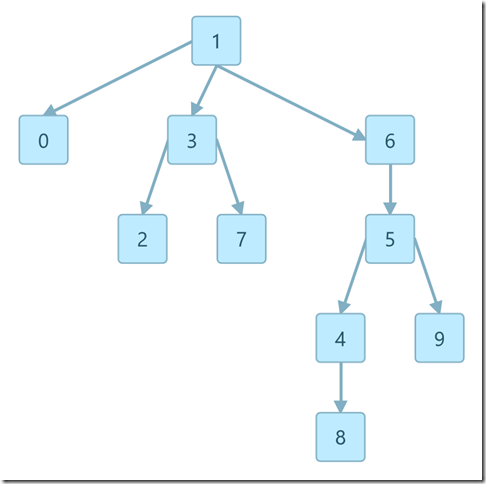
在加权 quick-union 算法中,假设我们将 id[find(p)] 的值设为 q 而非 id[find[q]],所得的算法是正确的吗?
答:是,但这会增加树的高度,因此无法保证同样的性能。
本题答案已经给出,也很好理解。
如果合并时只是把子树挂到结点 q 上而非其根节点,树的高度会明显增加,进而增加每次 Find() 操作的开销。
实现加权 quick-find 算法,其中我们总是将较小的分量重命名为较大分量的标识符。
这种改变会对性能产生怎样的影响?
类似于加权 quick-union 的做法,新增一个 size[] 数组以记录各个根节点的大小。
每次合并时先比较一下两棵树的大小,再进行合并。
这样会略微减少赋值语句的执行次数,提升性能。
WeightedQuickFindUF.cs
using System; namespace _1._5._11 { /// <summary> /// 用加权 QuickFind 算法实现的并查集。 /// </summary> public class WeightedQuickFindUF { private int[] size; // 记录每个连通分量的大小。 private int[] id; // 记录每个结点的连通分量。 private int count;// 连通分量总数。 public int ArrayVisitCount { get; private set; } //记录数组访问的次数。 /// <summary> /// 新建一个使用加权 quick-find 实现的并查集。 /// </summary> /// <param name="n">并查集的大小。</param> public WeightedQuickFindUF(int n) { this.count = n; this.id = new int[n]; this.size = new int[n]; for (int i = 0; i < n; ++i) { this.id[i] = i; this.size[i] = 1; } } /// <summary> /// 重置数组访问计数。 /// </summary> public void ResetArrayCount() { this.ArrayVisitCount = 0; } /// <summary> /// 表示并查集中连通分量的数量。 /// </summary> /// <returns>返回并查集中连通分量的数量。</returns> public int Count() { return this.count; } /// <summary> /// 寻找 p 所在的连通分量。 /// </summary> /// <param name="p">需要寻找的结点。</param> /// <returns>返回 p 所在的连通分量。</returns> public int Find(int p) { Validate(p); this.ArrayVisitCount++; return this.id[p]; } /// <summary> /// 判断两个结点是否属于同一个连通分量。 /// </summary> /// <param name="p">需要判断的结点。</param> /// <param name="q">需要判断的另一个结点。</param> /// <returns>如果属于同一个连通分量则返回 true,否则返回 false。</returns> public bool IsConnected(int p, int q) { Validate(p); Validate(q); this.ArrayVisitCount += 2; return this.id[p] == this.id[q]; } /// <summary> /// 将两个结点所在的连通分量合并。 /// </summary> /// <param name="p">需要合并的结点。</param> /// <param name="q">需要合并的另一个结点。</param> public void Union(int p, int q) { Validate(p); Validate(q); int pID = this.id[p]; int qID = this.id[q]; this.ArrayVisitCount += 2; // 如果两个结点同属于一个连通分量,那么什么也不做。 if (pID == qID) { return; } // 判断较大的连通分量和较小的连通分量。 int larger = 0; int smaller = 0; if (this.size[pID] > this.size[qID]) { larger = pID; smaller = qID; this.size[pID] += this.size[qID]; } else { larger = qID; smaller = pID; this.size[qID] += this.size[pID]; } // 将较小的连通分量连接到较大的连通分量上, // 这会减少赋值语句的执行次数,略微减少数组访问。 for (int i = 0; i < this.id.Length; ++i) { if (this.id[i] == smaller) { this.id[i] = larger; this.ArrayVisitCount++; } } this.ArrayVisitCount += this.id.Length; this.count--; return; } /// <summary> /// 获得 id 数组。 /// </summary> /// <returns>id 数组。</returns> public int[] GetID() { return this.id; } /// <summary> /// 验证输入的结点是否有效。 /// </summary> /// <param name="p">需要验证的结点。</param> /// <exception cref="ArgumentException">输入的 p 值无效。</exception> private void Validate(int p) { int n = this.id.Length; if (p < 0 || p > n) { throw new ArgumentException("index " + p + " is not between 0 and " + (n - 1)); } } } }
Main 方法
using System; using UnionFind; namespace _1._5._11 { /* * 1.5.11 * * 实现加权 quick-find 算法,其中我们总是将较小的分量重命名为较大分量的标识符。 * 这种改变会对性能产生怎样的影响? * */ class Program { static void Main(string[] args) { char[] split = { '\n', '\r' }; string[] input = TestCase.Properties.Resources.mediumUF.Split(split, StringSplitOptions.RemoveEmptyEntries); int size = int.Parse(input[0]); QuickFindUF quickFind = new QuickFindUF(size); WeightedQuickFindUF weightedQuickFind = new WeightedQuickFindUF(size); int p, q; string[] pair; for (int i = 1; i < size; ++i) { pair = input[i].Split(' '); p = int.Parse(pair[0]); q = int.Parse(pair[1]); quickFind.Union(p, q); weightedQuickFind.Union(p, q); } Console.WriteLine("quick-find: " + quickFind.ArrayVisitCount); Console.WriteLine("weighted quick-find: " + weightedQuickFind.ArrayVisitCount); } } }
使用路径压缩的 quick-union 算法。
根据路径压缩修改 quick-union 算法(请见 1.5.2.3 节),在 find() 方法中添加一个循环来将从 p 到根节点的路径上的每个触点都连接到根节点。
给出一列输入,使该方法能够产生一条长度为 4 的路径。
注意:该算法的所有操作的均摊成本已知为对数级别。
QuickUnionPathCompression 的官方实现:QuickUnionPathCompressionUF.java
在找到根节点之后,再访问一遍 p 到根节点这条路径上的所有结点,将它们直接和根节点相连。
重写过后的 Find() 方法:
/// <summary> /// 寻找结点所属的连通分量。 /// </summary> /// <param name="p">需要寻找的结点。</param> /// <returns>结点所属的连通分量。</returns> public override int Find(int p) { int root = p; while (root != this.parent[root]) { root = this.parent[root]; } while (p != root) { int newp = this.parent[p]; this.parent[p] = root; p = newp; } return p; }
由于路径压缩是在 Find() 方法中实现的,只要输入保证是根节点两两相连即可构造较长的路径。
QuickUnionPathCompressionUF.cs 直接从 QuickUnionUF.cs 继承而来。
关于 QuickUnionUF.cs,参见 1.5.2 的解答。
namespace UnionFind { /// <summary> /// 使用路径压缩的 quick-union 并查集。 /// </summary> public class QuickUnionPathCompressionUF : QuickFindUF { /// <summary> /// 新建一个大小为 n 的并查集。 /// </summary> /// <param name="n">新建并查集的大小。</param> public QuickUnionPathCompressionUF(int n) : base(n) { } /// <summary> /// 寻找结点所属的连通分量。 /// </summary> /// <param name="p">需要寻找的结点。</param> /// <returns>结点所属的连通分量。</returns> public override int Find(int p) { int root = p; while (root != this.parent[root]) { root = this.parent[root]; } while (p != root) { int newp = this.parent[p]; this.parent[p] = root; p = newp; } return p; } } }
Main 方法
using System; using UnionFind; namespace _1._5._12 { /* * 1.5.12 * * 使用路径压缩的 quick-union 算法。 * 根据路径压缩修改 quick-union 算法(请见 1.5.2.3 节), * 在 find() 方法中添加一个循环来将从 p 到根节点的路径上的每个触点都连接到根节点。 * 给出一列输入,使该方法能够产生一条长度为 4 的路径。 * 注意:该算法的所有操作的均摊成本已知为对数级别。 * */ class Program { static void Main(string[] args) { var UF = new QuickUnionPathCompressionUF(10); // 使用书中提到的最坏情况,0 连 1,1 连 2,2 连 3…… for (int i = 0; i < 4; ++i) { UF.Union(i, i + 1); } int[] id = UF.GetParent(); for (int i = 0; i < id.Length; ++i) { Console.Write(id[i]); } Console.WriteLine(); } } }
使用路径压缩的加权 quick-union 算法。
修改加权 quick-union 算法(算法 1.5),实现如练习 1.5.12 所述的路径压缩。
给出一列输入,使该方法能产生一棵高度为 4 的树。
注意:该算法的所有操作的均摊成本已知被限制在反 Ackermann 函数的范围之内,且对于实际应用中可能出现的所有 N 值均小于 5。
官方实现:WeightedQuickUnionPathCompressionUF。
加权 quick-union 中,两个大小相等的树合并可以有效增加高度,同时输入必须保证是根节点以规避路径压缩。
WeightedQuickUnionPathCompressionUF.cs 从 WeightedQuickUnionUF.cs 继承,详情参见 1.5.3 的解答。
namespace UnionFind { /// <summary> /// 使用路径压缩的加权 quick-union 并查集。 /// </summary> public class WeightedQuickUnionPathCompressionUF : WeightedQuickUnionUF { /// <summary> /// 新建一个大小为 n 的并查集。 /// </summary> /// <param name="n">新建并查集的大小。</param> public WeightedQuickUnionPathCompressionUF(int n) : base(n) { this.size = new int[n]; for (int i = 0; i < n; ++i) { this.size[i] = 1; } } /// <summary> /// 寻找一个结点所在的连通分量。 /// </summary> /// <param name="p">需要寻找的结点。</param> /// <returns>该结点所属的连通分量。</returns> public override int Find(int p) { Validate(p); int root = p; while (root != this.parent[p]) { root = this.parent[p]; } while (p != root) { int newP = this.parent[p]; this.parent[p] = root; p = newP; } return root; } } }
Main 方法
using System; using UnionFind; namespace _1._5._13 { /* * 1.5.13 * * 使用路径压缩的加权 quick-union 算法。 * 修改加权 quick-union 算法(算法 1.5), * 实现如练习 1.5.12 所述的路径压缩。给出一列输入, * 使该方法能产生一棵高度为 4 的树。 * 注意:该算法的所有操作的均摊成本已知被限制在反 Ackermann 函数的范围之内, * 且对于实际应用中可能出现的所有 N 值均小于 5。 * */ class Program { static void Main(string[] args) { var UF = new WeightedQuickUnionPathCompressionUF(10); // 见中文版 P146 或英文版 P229 中加权 quick-union 的最坏输入。 UF.Union(0, 1); UF.Union(2, 3); UF.Union(4, 5); UF.Union(6, 7); UF.Union(0, 2); UF.Union(4, 6); UF.Union(0, 4); int[] id = UF.GetParent(); for (int i = 0; i < id.Length; ++i) { Console.Write(id[i]); } Console.WriteLine(); } } }
根据高度加权的 quick-union 算法。
给出 UF 的一个实现,使用和加权 quick-union 算法相同的策略,但记录的是树的高度并总是将较矮的树连接到较高的树上。
用算法证明 N 个触点的树的高度不会超过其大小的对数级别。
WeightedQuickUnionByHeight 的官方实现:WeightedQuickUnionByHeightUF.java。
证明:
一次 Union 操作只可能发生如下两种情况。
1.两棵树的高度相同,这样合并后的新树的高度等于较大那棵树的高度 + 1。
2.两棵树的高度不同,这样合并后的新树高度等于较大那棵树的高度。
现在证明通过加权 quick-union 算法构造的高度为 h 的树至少包含 2h 个结点。
基础情况,高度 h = 0, 结点数 k = 1。
为了使高度增加,必须用一棵高度相同的树合并,而 h = 0 时结点数一定是 1,则:
h = 1, k = 2
由于两棵大小不同的树合并,最大高度不会增加,只会增加结点数。
因此,每次都使用相同高度的最小树进行合并,有:
h = 2, k = 4
h = 3, k = 8
h = 4, k = 16
......
递推即可得到结论,k ≥ 2h
因此 h <= lgk
namespace UnionFind { public class WeightedQuickUnionByHeightUF : QuickUnionUF { private int[] height; /// <summary> /// 新建一个以高度作为判断依据的加权 quick-union 并查集。 /// </summary> /// <param name="n">新建并查集的大小。</param> public WeightedQuickUnionByHeightUF(int n) : base(n) { this.height = new int[n]; for (int i = 0; i < n; ++i) { this.height[i] = 0; } } /// <summary> /// 将两个结点所属的连通分量合并。 /// </summary> /// <param name="p">需要合并的结点。</param> /// <param name="q">需要合并的另一个结点。</param> public override void Union(int p, int q) { int rootP = Find(p); int rootQ = Find(q); if (rootP == rootQ) { return; } if (this.height[rootP] < this.height[rootQ]) { this.parent[rootP] = rootQ; } else if (this.height[rootP] > this.height[rootQ]) { this.parent[rootQ] = rootP; } else { this.parent[rootQ] = rootP; this.height[rootP]++; } this.count--; } } }
二项树。
请证明,对于加权 quick-union 算法,在最坏情况下树中的每一层的结点数均为二项式系数。
在这种情况下,计算含有 N=2^n 个节点的树中节点的平均深度。
首先证明在最坏情况下加权 quick-union 算法生成的树中的每一层结点数均为二项式系数。
最坏情况下,每次 union 操作都是合并相同大小的树,如下图所示:
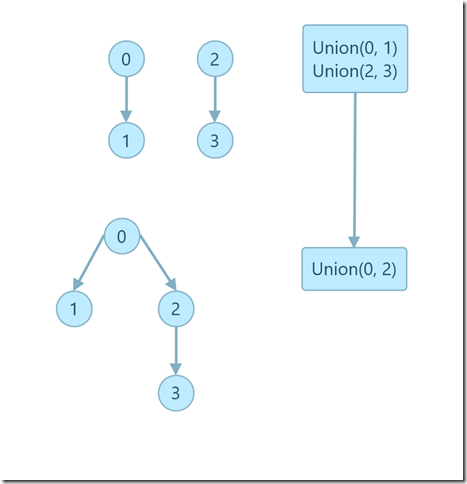
设第 i 层的结点数为 ki,那么最坏情况下每次合并后的 ki’ = ki + ki-1 。
这符合二项式系数的构造特点(详情可以搜索杨辉三角),第一个结论证明完毕。
接下来求平均深度,首先根据二项式的求和公式,一棵深度为 n 的树(根结点的深度为零)结点总数为:
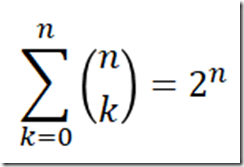
每层结点数 × 该层深度后的和为:

这里用到了这个公式化简:

相除可以求得平均深度:

均摊成本的图像。修改你为练习 1.5.7 给出的实现,绘出如正文所示的均摊成本的图像。
给出绘图结果样例:
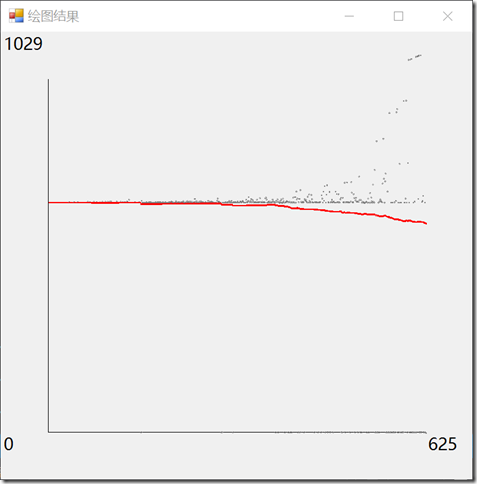
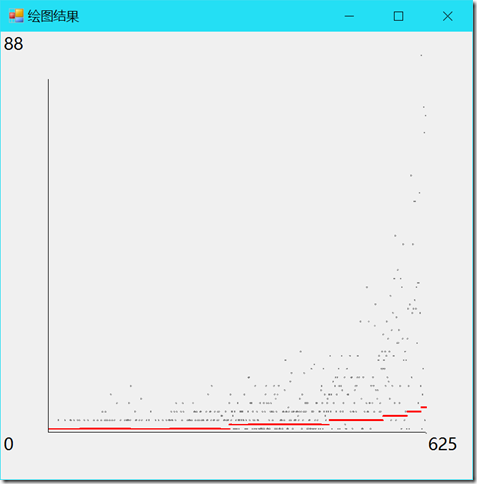
仅给出绘图相关的代码,窗体部分见 github 上的代码:
using System; using System.Linq; using System.Windows.Forms; using System.Drawing; using UnionFind; namespace _1._5._16 { /* * 1.5.16 * * 均摊成本的图像。 * 修改你为练习 1.5.7 给出的实现, * 绘出如正文所示的均摊成本的图像。 * */ static class Program { [STAThread] static void Main() { Application.EnableVisualStyles(); Application.SetCompatibleTextRenderingDefault(false); Compute(); Application.Run(new Form1()); } static void Compute() { char[] split = { '\n', '\r' }; string[] input = TestCase.Properties.Resources.mediumUF.Split(split, StringSplitOptions.RemoveEmptyEntries); int size = int.Parse(input[0]); QuickFindUF quickFind = new QuickFindUF(size); QuickUnionUF quickUnion = new QuickUnionUF(size); string[] pair; int p, q; int[] quickFindResult = new int[size]; int[] quickUnionResult = new int[size]; for (int i = 1; i < size; ++i) { pair = input[i].Split(' '); p = int.Parse(pair[0]); q = int.Parse(pair[1]); quickFind.Union(p, q); quickUnion.Union(p, q); quickFindResult[i - 1] = quickFind.ArrayVisitCount; quickUnionResult[i - 1] = quickUnion.ArrayVisitCount; quickFind.ResetArrayCount(); quickUnion.ResetArrayCount(); } Draw(quickFindResult); Draw(quickUnionResult); } static void Draw(int[] cost) { // 构建 total 数组。 int[] total = new int[cost.Length]; total[0] = cost[0]; for (int i = 1; i < cost.Length; ++i) { total[i] = total[i - 1] + cost[i]; } // 获得最大值。 int costMax = cost.Max(); // 新建绘图窗口。 Form2 plot = new Form2(); plot.Show(); Graphics graphics = plot.CreateGraphics(); // 获得绘图区矩形。 RectangleF rect = plot.ClientRectangle; float unitX = rect.Width / 10; float unitY = rect.Width / 10; // 添加 10% 边距作为文字区域。 RectangleF center = new RectangleF (rect.X + unitX, rect.Y + unitY, rect.Width - 2 * unitX, rect.Height - 2 * unitY); // 绘制坐标系。 graphics.DrawLine(Pens.Black, center.Left, center.Top, center.Left, center.Bottom); graphics.DrawLine(Pens.Black, center.Left, center.Bottom, center.Right, center.Bottom); graphics.DrawString(costMax.ToString(), plot.Font, Brushes.Black, rect.Location); graphics.DrawString(cost.Length.ToString(), plot.Font, Brushes.Black, center.Right, center.Bottom); graphics.DrawString("0", plot.Font, Brushes.Black, rect.Left, center.Bottom); // 初始化点。 PointF[] grayPoints = new PointF[cost.Length]; PointF[] redPoints = new PointF[cost.Length]; unitX = center.Width / cost.Length; unitY = center.Width / costMax; for (int i = 0; i < cost.Length; ++i) { grayPoints[i] = new PointF(center.Left + unitX * (i + 1), center.Bottom - (cost[i] * unitY)); redPoints[i] = new PointF(center.Left + unitX * (i + 1), center.Bottom - ((total[i] / (i + 1)) * unitY)); } // 绘制点。 for (int i = 0; i < cost.Length; ++i) { graphics.DrawEllipse(Pens.Gray, new RectangleF(grayPoints[i], new SizeF(2, 2))); graphics.DrawEllipse(Pens.Red, new RectangleF(redPoints[i], new SizeF(2, 2))); } graphics.Dispose(); } } }
随机链接。
设计 UF 的一个用例 ErdosRenyi,
从命令行接受一个整数 N,在 0 到 N-1 之间产生随机整数对,调用 connected() 判断它们是否相连,如果不是则调用 union() 方法(和我们的开发用例一样)。
不断循环直到所有触点均相互连通并打印出生成的连接总数。
将你的程序打包成一个接受参数 N 并返回连接总数的静态方法 count(),添加一个 main() 方法从命令行接受 N,调用 count() 并打印它的返回值。
官方给出的 ErdosRenyi:ErdosRenyi.java。
为了方便之后做题,除了 Count() 之外,这个类还包含其他方法,具体可以查看注释。
ErdosRenyi.cs
using System; using System.Collections.Generic; namespace UnionFind { /// <summary> /// 提供一系列对并查集进行随机测试的静态方法。 /// </summary> public class ErdosRenyi { /// <summary> /// 随机生成一组能让并查集只剩一个连通分量的连接。 /// </summary> /// <param name="n">并查集大小。</param> /// <returns>一组能让并查集只剩一个连通分量的连接。</returns> public static Connection[] Generate(int n) { Random random = new Random(); List<Connection> connections = new List<Connection>(); WeightedQuickUnionPathCompressionUF uf = new WeightedQuickUnionPathCompressionUF(n); while (uf.Count() > 1) { int p = random.Next(n); int q = random.Next(n); uf.Union(p, q); connections.Add(new Connection(p, q)); } return connections.ToArray(); } /// <summary> /// 随机生成连接,返回令并查集中只剩一个连通分量所需的连接总数。 /// </summary> /// <param name="uf">用于测试的并查集。</param> /// <returns>需要的连接总数。</returns> public static int Count(UF uf) { Random random = new Random(); int size = uf.Count(); int edges = 0; while (uf.Count() > 1) { int p = random.Next(size); int q = random.Next(size); uf.Union(p, q); edges++; } return edges; } /// <summary> /// 使用指定的连接按顺序合并。 /// </summary> /// <param name="uf">需要测试的并查集。</param> /// <param name="connections">用于输入的连接集合。</param> public static void Count(UF uf, Connection[] connections) { foreach (Connection c in connections) { uf.Union(c.P, c.Q); } } } }
Main 方法:
using System; using UnionFind; namespace _1._5._17 { /* * 1.5.17 * * 随机链接。 * 设计 UF 的一个用例 ErdosRenyi, * 从命令行接受一个整数 N,在 0 到 N-1 之间产生随机整数对, * 调用 connected() 判断它们是否相连, * 如果不是则调用 union() 方法(和我们的开发用例一样)。 * 不断循环直到所有触点均相互连通并打印出生成的连接总数。 * 将你的程序打包成一个接受参数 N 并返回连接总数的静态方法 count(), * 添加一个 main() 方法从命令行接受 N,调用 count() 并打印它的返回值。 * */ class Program { static void Main(string[] args) { int N = 10; int[] edges = new int[5]; for (int i = 0; i < 5; ++i) { var uf = new UF(N); Console.WriteLine(N + "\t" + ErdosRenyi.Count(uf)); N *= 10; } } } }
随机网格生成器。
编写一个程序 RandomGrid,从命令行接受一个 int 值 N,生成一个 N×N 的网格中的所有连接。
它们的排列随机且方向随机(即 (p q) 和 (q p) 出现的可能性是相等的),将这个结果打印到标准输出中。
可以使用 RandomBag 将所有连接随机排列(请见练习 1.3.34),并使用如右下所示的 Connection 嵌套类来将 p 和 q 封装到一个对象中。
将程序打包成两个静态方法:generate(),接受参数 N 并返回一个连接的数组;main(),从命令行接受参数 N,调用 generate(),便利返回的数组并打印出所有连接。
private class Connection { int p; int q; public Connection(int p, int q) { this.p = p; this.q = q; } }
具体生成的连接样式见下题,这里给出 RandomGrid 的实现,需要使用 1.3 节中的随机背包辅助。
RandomGrid.cs
using System; using System.Collections.Generic; namespace UnionFind { public class RandomGrid { /// <summary> /// 随机生成 n × n 网格中的所有连接。 /// </summary> /// <param name="n">网格边长。</param> /// <returns>随机排序的连接。</returns> public static RandomBag<Connection> Generate(int n) { var result = new RandomBag<Connection>(); var random = new Random(); // 建立横向连接 for (int i = 0; i < n; ++i) { for (int j = 0; j < n - 1; ++j) { if (random.Next(10) > 4) { result.Add(new Connection(i * n + j, (i * n) + j + 1)); } else { result.Add(new Connection((i * n) + j + 1, i * n + j)); } } } // 建立纵向连接 for (int j = 0; j < n; ++j) { for (int i = 0; i < n - 1; ++i) { if (random.Next(10) > 4) { result.Add(new Connection(i * n + j, ((i + 1) * n) + j)); } else { result.Add(new Connection(((i + 1) * n) + j, i * n + j)); } } } return result; } /// <summary> /// 随机生成 n × n 网格中的所有连接,返回一个连接数组。 /// </summary> /// <param name="n">网格边长。</param> /// <returns>连接数组。</returns> public static Connection[] GetConnections(int n) { RandomBag<Connection> bag = Generate(n); List<Connection> connections = new List<Connection>(); foreach (Connection c in bag) { connections.Add(c); } return connections.ToArray(); } } }
动画。
编写一个 RandomGrid(请见练习 1.5.18)的用例,
和我们开发用例一样使用 UnionFind 来检查触点的连通性并在处理时用 StdDraw 将它们绘出。
最后绘出的图像:
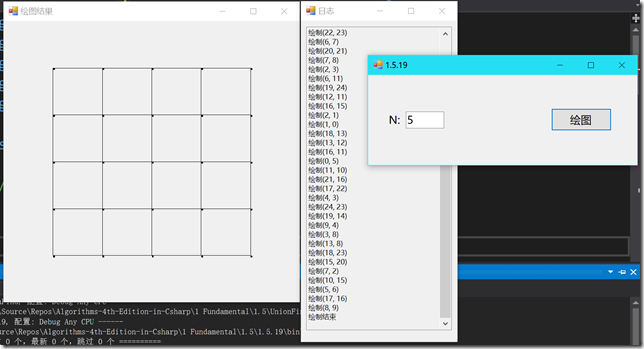
给出绘图部分的代码,窗体部分见 GitHub。
using System; using System.Drawing; using System.Collections.Generic; using System.Windows.Forms; using UnionFind; namespace _1._5._19 { /* * 1.5.19 * * 动画。 * 编写一个 RandomGrid(请见练习 1.5.18)的用例, * 和我们开发用例一样使用 UnionFind 来检查触点的连通性并在处理时用 StdDraw 将它们绘出。 * */ static class Program { static RandomBag<Connection> bag; static Graphics graphics; static TextBox logBox; static PointF[] points; static Timer timer; static List<Connection> connections; static int count = 0; /// <summary> /// 应用程序的主入口点。 /// </summary> [STAThread] static void Main() { Application.EnableVisualStyles(); Application.SetCompatibleTextRenderingDefault(false); Application.Run(new Form1()); } /// <summary> /// 绘制连接图像。 /// </summary> /// <param name="n">矩阵边长。</param> public static void Draw(int n, TextBox log, Log WinBox) { logBox = log; // 生成路径。 log.AppendText("\r\n开始生成连接……"); bag = RandomGrid.Generate(n); log.AppendText("\r\n生成连接完成"); // 新建画布窗口。 log.AppendText("\r\n启动画布……"); Form2 matrix = new Form2(); matrix.StartPosition = FormStartPosition.Manual; matrix.Location = new Point(WinBox.Left - matrix.ClientRectangle.Width, WinBox.Top); matrix.Show(); log.AppendText("\r\n画布已启动,开始绘图……"); graphics = matrix.CreateGraphics(); // 获取绘图区域。 RectangleF rect = matrix.ClientRectangle; float unitX = rect.Width / (n + 1); float unitY = rect.Height / (n + 1); // 绘制点。 log.AppendText("\r\n绘制点……"); points = new PointF[n * n]; for (int row = 0; row < n; ++row) { for (int col = 0; col < n; ++col) { points[row * n + col] = new PointF(unitX * (col + 1), unitY * (row + 1)); graphics.FillEllipse(Brushes.Black, unitX * (col + 1), unitY * (row + 1), 5, 5); } } log.AppendText("\r\n绘制点完成"); // 绘制连接。 log.AppendText("\r\n开始绘制连接……"); connections = new List<Connection>(); foreach (Connection c in bag) { connections.Add(c); } timer = new Timer { Interval = 500 }; timer.Tick += DrawOneLine; timer.Start(); } private static void DrawOneLine(object sender, EventArgs e) { Connection c = connections[count]; count++; graphics.DrawLine(Pens.Black, points[c.P], points[c.Q]); logBox.AppendText("\r\n绘制" + "(" + c.P + ", " + c.Q + ")"); if (count == bag.Size()) { timer.Stop(); logBox.AppendText("\r\n绘制结束"); count = 0; } } } }
动态生长。
使用链表或大小可变的数组实现加权 quick-union 算法,
去掉需要预先知道对象数量的限制。
为 API 添加一个新方法 newSite(),它应该返回一个类型为 int 的标识符。
将 parent 数组和 size 数组用链表代替即可,很容易实现。
修改后的 WeightedQuickUnionUF.cs
using System; namespace _1._5._20 { /// <summary> /// 使用加权 quick-union 算法的并查集。 /// </summary> public class WeightedQuickUnionUF { protected LinkedList<int> parent; // 记录各个结点的父级。 protected LinkedList<int> size; // 记录各个树的大小。 protected int count; // 分量数目。 /// <summary> /// 建立使用加权 quick-union 的并查集。 /// </summary> /// <param name="n">并查集的大小。</param> public WeightedQuickUnionUF() { this.parent = new LinkedList<int>(); this.size = new LinkedList<int>(); } /// <summary> /// 获取 parent 数组。 /// </summary> /// <returns>parent 数组。</returns> public LinkedList<int> GetParent() { return this.parent; } /// <summary> /// 获取 size 数组。 /// </summary> /// <returns>返回 size 数组。</returns> public LinkedList<int> GetSize() { return this.size; } /// <summary> /// 在并查集中增加一个新的结点。 /// </summary> /// <returns>新结点的下标。</returns> public int NewSite() { this.parent.Insert(this.parent.Size(), this.parent.Size()); this.size.Insert(1, this.size.Size()); this.count++; return this.parent.Size() - 1; } /// <summary> /// 寻找一个结点所在的连通分量。 /// </summary> /// <param name="p">需要寻找的结点。</param> /// <returns>该结点所属的连通分量。</returns> public int Find(int p) { Validate(p); while (p != this.parent.Find(p)) { p = this.parent.Find(p); } return p; } /// <summary> /// 将两个结点所属的连通分量合并。 /// </summary> /// <param name="p">需要合并的结点。</param> /// <param name="q">需要合并的另一个结点。</param> public void Union(int p, int q) { int rootP = Find(p); int rootQ = Find(q); if (rootP == rootQ) { return; } if (this.size.Find(rootP) < this.size.Find(rootQ)) { this.parent.Motify(rootP, rootQ); this.size.Motify(rootQ, this.size.Find(rootQ) + this.size.Find(rootP)); } else { this.parent.Motify(rootQ, rootP); this.size.Motify(rootP, this.size.Find(rootQ) + this.size.Find(rootP)); } this.count--; } /// <summary> /// 检查输入的 p 是否符合条件。 /// </summary> /// <param name="p">输入的 p 值。</param> protected void Validate(int p) { int n = this.parent.Size(); if (p < 0 || p >= n) { throw new ArgumentException("index" + p + " is not between 0 and " + (n - 1)); } } } }
Erd?s-Renyi 模型。
使用练习 1.5.17 的用例验证这个猜想:得到单个连通分量所需生成的整数对数量为 ~1/2NlnN。
给出我电脑上的结果:
实验结果:10 1/2NlnN:11.5129254649702 实验结果:29 1/2NlnN:29.9573227355399 实验结果:132 1/2NlnN:73.7775890822787 实验结果:164 1/2NlnN:175.281065386955 实验结果:418 1/2NlnN:406.013905218706 实验结果:1143 1/2NlnN:922.931359327004 实验结果:2004 1/2NlnN:2067.66981643319 实验结果:4769 1/2NlnN:4578.95382842474 实验结果:10422 1/2NlnN:10045.1360479662 实验结果:21980 1/2NlnN:21864.7288781659
using System; using UnionFind; namespace _1._5._21 { /* * 1.5.21 * * Erd?s-Renyi 模型。 * 使用练习 1.5.17 的用例验证这个猜想: * 得到单个连通分量所需生成的整数对数量为 ~1/2NlnN。 * */ class Program { static void Main(string[] args) { for (int n = 10; n < 10000; n *= 2) { int total = 0; for (int i = 0; i < 100; ++i) { UF uf = new UF(n); total += ErdosRenyi.Count(uf); } Console.WriteLine("实验结果:" + total / 100); Console.WriteLine("1/2NlnN:" + Math.Log(n) * n * 0.5); Console.WriteLine(); } } } }
Erd?s-Renyi 的倍率实验。
开发一个性能测试用例,从命令行接受一个 int 值 T 并进行 T 次以下实验:
使用练习 1.5.17 的用例生成随机连接,和我们的开发用例一样使用 UnionFind 来检查触点的连通性,不断循环直到所有触点都相互连通。
对于每个 N,打印出 N 值和平均所需的连接数以及前后两次运行时间的比值。
使用你的程序验证正文中的猜想:quick-find 算法和 quick-union 算法的运行时间是平方级别的,加权 quick-union 算法则接近线性级别。
平方级别算法在输入加倍后耗时应该增加四倍,线性则是两倍。
下面给出我电脑上的结果,数据量较大时比较明显:
N:16000 quick-find 平均次数:8452 用时:143 比值:4.46875 quick-union 平均次数:7325 用时:202 比值:3.25806451612903 weighted-quick-union 平均次数:6889 用时:1 N:32000 quick-find 平均次数:15747 用时:510 比值:3.56643356643357 quick-union 平均次数:15108 用时:801 比值:3.96534653465347 weighted-quick-union 平均次数:17575 用时:3 比值:3 N:64000 quick-find 平均次数:33116 用时:2069 比值:4.05686274509804 quick-union 平均次数:38608 用时:4635 比值:5.78651685393258 weighted-quick-union 平均次数:34850 用时:6 比值:2
using System; using System.Diagnostics; using UnionFind; namespace _1._5._22 { /* * 1.5.22 * * Erd?s-Renyi 的倍率实验。 * 开发一个性能测试用例, * 从命令行接受一个 int 值 T 并进行 T 次以下实验: * 使用练习 1.5.17 的用例生成随机连接, * 和我们的开发用例一样使用 UnionFind 来检查触点的连通性, * 不断循环知道所有触点都相互连通。 * 对于每个 N,打印出 N 值和平均所需的连接数以及前后两次运行时间的比值。 * 使用你的程序验证正文中的猜想: * quick-find 算法和 quick-union 算法的运行时间是平方级别的, * 加权 quick-union 算法则接近线性级别。 * */ class Program { static void Main(string[] args) { long lastTimeQuickFind = 0; long lastTimeQuickUnion = 0; long lastTimeWeightedQuickUnion = 0; long nowTime = 0; for (int n = 2000; n < 100000; n *= 2) { Console.WriteLine("N:" + n); QuickFindUF quickFindUF = new QuickFindUF(n); QuickUnionUF quickUnionUF = new QuickUnionUF(n); WeightedQuickUnionUF weightedQuickUnionUF = new WeightedQuickUnionUF(n); // quick-find Console.WriteLine("quick-find"); nowTime = RunTest(quickFindUF); if (lastTimeQuickFind == 0) { Console.WriteLine("用时:" + nowTime); lastTimeQuickFind = nowTime; } else { Console.WriteLine("用时:" + nowTime + " 比值:" + (double)nowTime / lastTimeQuickFind); lastTimeQuickFind = nowTime; } Console.WriteLine(); // quick-union Console.WriteLine("quick-union"); nowTime = RunTest(quickUnionUF); if (lastTimeQuickUnion == 0) { Console.WriteLine("用时:" + nowTime); lastTimeQuickUnion = nowTime; } else { Console.WriteLine("用时:" + nowTime + " 比值:" + (double)nowTime / lastTimeQuickUnion); lastTimeQuickUnion = nowTime; } Console.WriteLine(); // weighted-quick-union Console.WriteLine("weighted-quick-union"); nowTime = RunTest(weightedQuickUnionUF); if (lastTimeWeightedQuickUnion == 0) { Console.WriteLine("用时:" + nowTime); lastTimeWeightedQuickUnion = nowTime; } else { Console.WriteLine("用时:" + nowTime + " 比值:" + (double)nowTime / lastTimeWeightedQuickUnion); lastTimeWeightedQuickUnion = nowTime; } Console.WriteLine(); Console.WriteLine(); } } /// <summary> /// 进行若干次随机试验,输出平均 union 次数,返回平均耗时。 /// </summary> /// <param name="uf">用于测试的并查集。</param> /// <returns>平均耗时。</returns> static long RunTest(UF uf) { Stopwatch timer = new Stopwatch(); int total = 0; int repeatTime = 10; timer.Start(); for (int i = 0; i < repeatTime; ++i) { total += ErdosRenyi.Count(uf); } timer.Stop(); Console.WriteLine("平均次数:" + total / repeatTime); return timer.ElapsedMilliseconds / repeatTime; } } }
在 Erd?s-Renyi 模型下比较 quick-find 算法和 quick-union 算法。
开发一个性能测试用例,从命令行接受一个 int 值 T 并进行 T 次以下实验:使用练习 1.5.17 的用例生成随机连接。
保存这些连接并和我们的开发用例一样分别用 quick-find 和 quick-union 算法检查触点的连通性,不断循环直到所有触点均相互连通。
对于每个 N,打印出 N 值和两种算法的运行时间比值。
先用速度最快的 WeightedQuickUnionUF 生成一系列连接,保存后用这些连接进行测试,生成连接的方法见 1.5.17 的解答。
下面给出我电脑上的结果:
N:2000 quick-find 耗时(毫秒):4 quick-union 耗时(毫秒):5 比值:0.8 N:4000 quick-find 耗时(毫秒):19 quick-union 耗时(毫秒):24 比值:0.791666666666667 N:8000 quick-find 耗时(毫秒):57 quick-union 耗时(毫秒):74 比值:0.77027027027027 N:16000 quick-find 耗时(毫秒):204 quick-union 耗时(毫秒):307 比值:0.664495114006515 N:32000 quick-find 耗时(毫秒):1127 quick-union 耗时(毫秒):1609 比值:0.700435052827843
using System; using System.Diagnostics; using UnionFind; namespace _1._5._23 { /* * 1.5.23 * * 在 Erd?s-Renyi 模型下比较 quick-find 算法和 quick-union 算法。 * 开发一个性能测试用例,从命令行接受一个 int 值 T 并进行 T 次以下实验: * 使用练习 1.5.17 的用例生成随机连接。 * 保存这些连接并和我们的开发用例一样分别用 quick-find 和 quick-union 算法检查触点的连通性, * 不断循环直到所有触点均相互连通。 * 对于每个 N,打印出 N 值和两种算法的运行时间比值。 * */ class Program { static void Main(string[] args) { int n = 1000; for (int t = 0; t < 5; ++t) { Connection[] input = ErdosRenyi.Generate(n); QuickFindUF quickFind = new QuickFindUF(n); QuickUnionUF quickUnion = new QuickUnionUF(n); Console.WriteLine("N:" + n); long quickFindTime = RunTest(quickFind, input); long quickUnionTime = RunTest(quickUnion, input); Console.WriteLine("quick-find 耗时(毫秒):" + quickFindTime); Console.WriteLine("quick-union 耗时(毫秒):" + quickUnionTime); Console.WriteLine("比值:" + (double)quickFindTime / quickUnionTime); Console.WriteLine(); n *= 2; } } /// <summary> /// 进行若干次随机试验,输出平均 union 次数,返回平均耗时。 /// </summary> /// <param name="uf">用于测试的并查集。</param> /// <param name="connections">用于测试的输入。</param> /// <returns>平均耗时。</returns> static long RunTest(UF uf, Connection[] connections) { Stopwatch timer = new Stopwatch(); int repeatTime = 5; timer.Start(); for (int i = 0; i < repeatTime; ++i) { ErdosRenyi.Count(uf, connections); } timer.Stop(); return timer.ElapsedMilliseconds / repeatTime; } } }
适用于 Erd?s-Renyi 模型的快速算法。
在练习1.5.23 的测试中增加加权 quick-union 算法和使用路径压缩的加权 quick-union 算法。
你能分辨出这两种算法的区别吗?
根据上题的代码略作修改即可,路径压缩大概可以快 1/3。
N:10000 加权 quick-find 耗时(毫秒):9 带路径压缩的加权 quick-union 耗时(毫秒):6 比值:1.5 N:20000 加权 quick-find 耗时(毫秒):12 带路径压缩的加权 quick-union 耗时(毫秒):8 比值:1.5 N:40000 加权 quick-find 耗时(毫秒):18 带路径压缩的加权 quick-union 耗时(毫秒):12 比值:1.5 N:80000 加权 quick-find 耗时(毫秒):36 带路径压缩的加权 quick-union 耗时(毫秒):30 比值:1.2 N:160000 加权 quick-find 耗时(毫秒):67 带路径压缩的加权 quick-union 耗时(毫秒):41 比值:1.63414634146341
using System; using UnionFind; using System.Diagnostics; namespace _1._5._24 { /* * 1.5.24 * * 适用于 Erd?s-Renyi 模型的快速算法。 * 在练习1.5.23 的测试中增加加权 quick-union 算法和使用路径压缩的加权 quick-union 算法。 * 你能分辨出这两种算法的区别吗? * */ class Program { static void Main(string[] args) { int n = 5000; for (int t = 0; t < 5; ++t) { var input = ErdosRenyi.Generate(n); var weightedQuickUnionUF = new WeightedQuickUnionUF(n); var weightedQuickUnionPathCompressionUF = new WeightedQuickUnionPathCompressionUF(n); Console.WriteLine("N:" + n); long weightedQuickUnionTime = RunTest(weightedQuickUnionUF, input); long weightedQuickUnionPathCompressionTime = RunTest(weightedQuickUnionPathCompressionUF, input); Console.WriteLine("加权 quick-find 耗时(毫秒):" + weightedQuickUnionTime); Console.WriteLine("带路径压缩的加权 quick-union 耗时(毫秒):" + weightedQuickUnionPathCompressionTime); Console.WriteLine("比值:" + (double)weightedQuickUnionTime / weightedQuickUnionPathCompressionTime); Console.WriteLine(); n *= 2; } } /// <summary> /// 进行若干次随机试验,输出平均 union 次数,返回平均耗时。 /// </summary> /// <param name="uf">用于测试的并查集。</param> /// <param name="connections">用于测试的输入。</param> /// <returns>平均耗时。</returns> static long RunTest(UF uf, Connection[] connections) { Stopwatch timer = new Stopwatch(); int repeatTime = 5; timer.Start(); for (int i = 0; i < repeatTime; ++i) { ErdosRenyi.Count(uf, connections); } timer.Stop(); return timer.ElapsedMilliseconds / repeatTime; } } }
随机网格的倍率测试。
开发一个性能测试用例,从命令行接受一个 int 值 T 并进行 T 次以下实验:
使用练习 1.5.18 的用例生成一个 N×N 的随机网格,所有连接的方向随机且排列随机。
和我们的开发用例一样使用 UnionFind 来检查触点的连通性,不断循环直到所有触点均相互连通。
对于每个 N,打印出 N 值和平均所需的连接数以及前后两次运行时间的比值。
使用你的程序验证正文中的猜想:quick-find 和 quick-union 算法的运行时间是平方级别的,加权 quick-union 算法则接近线性级别。
注意:随着 N 值加倍,网格中触点的数量会乘以 4,因此平方级别的算法运行时间会变为原来的 16 倍,线性级别的算法的运行时间则变为原来的 4 倍。
略微修改 1.5.22 的代码即可。
我电脑上的结果:
Quick-Find N:1600 平均用时(毫秒):4 N:6400 平均用时(毫秒):67 比值:16.75 N:25600 平均用时(毫秒):1268 比值:18.9253731343284 N:102400 平均用时(毫秒):20554 比值:16.2097791798107 Quick-Union N:1600 平均用时(毫秒):5 比值:0.000243261652233142 N:6400 平均用时(毫秒):66 比值:13.2 N:25600 平均用时(毫秒):1067 比值:16.1666666666667 N:102400 平均用时(毫秒):18637 比值:17.4667291471415 Weighted Quick-Union N:1600 平均用时(毫秒):0 比值:0 N:6400 平均用时(毫秒):2 N:25600 平均用时(毫秒):12 比值:6 N:102400 平均用时(毫秒):64 比值:5.33333333333333
using System; using System.Diagnostics; using UnionFind; namespace _1._5._25 { /* * 1.5.25 * * 随机网格的倍率测试。 * 开发一个性能测试用例, * 从命令行接受一个 int 值 T 并进行 T 次以下实验: * 使用练习 1.5.18 的用例生成一个 N×N 的随机网格, * 所有连接的方向随机且排列随机。 * 和我们的开发用例一样使用 UnionFind 来检查触点的连通性, * 不断循环直到所有触点均相互连通。 * 对于每个 N,打印出 N 值和平均所需的连接数以及前后两次运行时间的比值。 * 使用你的程序验证正文中的猜想: * quick-find 和 quick-union 算法的运行时间是平方级别的, * 加权 quick-union 算法则接近线性级别。 * * 注意:随着 N 值加倍,网格中触点的数量会乘以 4, * 因此平方级别的算法运行时间会变为原来的 16 倍, * 线性级别的算法的运行时间则变为原来的 4 倍 * */ class Program { static void Main(string[] args) { int n = 40; int t = 4; // quick-find Console.WriteLine("Quick-Find"); long last = 0; long now = 0; for (int i = 0; i < t; ++i, n *= 2) { Console.WriteLine("N:" + n * n); var connections = RandomGrid.GetConnections(n); QuickFindUF quickFind = new QuickFindUF(n * n); now = RunTest(quickFind, connections); if (last == 0) { Console.WriteLine("平均用时(毫秒):" + now); last = now; } else { Console.WriteLine("平均用时(毫秒):" + now + "\t比值:" + (double)now / last); last = now; } } // quick-union Console.WriteLine("Quick-Union"); n = 40; for (int i = 0; i < t; ++i, n *= 2) { Console.WriteLine("N:" + n * n); var connections = RandomGrid.GetConnections(n); QuickUnionUF quickFind = new QuickUnionUF(n * n); now = RunTest(quickFind, connections); if (last == 0) { Console.WriteLine("平均用时(毫秒):" + now); last = now; } else { Console.WriteLine("平均用时(毫秒):" + now + "\t比值:" + (double)now / last); last = now; } } // 加权 quick-union Console.WriteLine("Weighted Quick-Union"); n = 40; for (int i = 0; i < t; ++i, n *= 2) { Console.WriteLine("N:" + n * n); var connections = RandomGrid.GetConnections(n); WeightedQuickUnionUF quickFind = new WeightedQuickUnionUF(n * n); now = RunTest(quickFind, connections); if (last == 0) { Console.WriteLine("平均用时(毫秒):" + now); last = now; } else { Console.WriteLine("平均用时(毫秒):" + now + "\t比值:" + (double)now / last); last = now; } } } /// <summary> /// 进行若干次随机试验,输出平均 union 次数,返回平均耗时。 /// </summary> /// <param name="uf">用于测试的并查集。</param> /// <param name="connections">用于测试的输入。</param> /// <returns>平均耗时。</returns> static long RunTest(UF uf, Connection[] connections) { Stopwatch timer = new Stopwatch(); long repeatTime = 3; timer.Start(); for (int i = 0; i < repeatTime; ++i) { ErdosRenyi.Count(uf, connections); } timer.Stop(); return timer.ElapsedMilliseconds / repeatTime; } } }
Erd?s-Renyi 模型的均摊成本图像。
开发一个用例,从命令行接受一个 int 值 N,在 0 到 N-1 之间产生随机整数对,调用 connected() 判断它们是否相连,如果不是则用 union() 方法(和我们的开发用例一样)。
不断循环直到所有触点互通。
按照正文的样式将所有操作的均摊成本绘制成图像。
和 1.5.16 的程序类似,将测试的内容改为 Erdos-Renyi 即可。
样例输出:
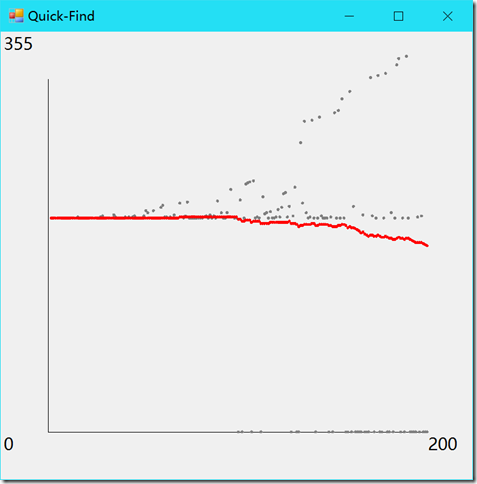
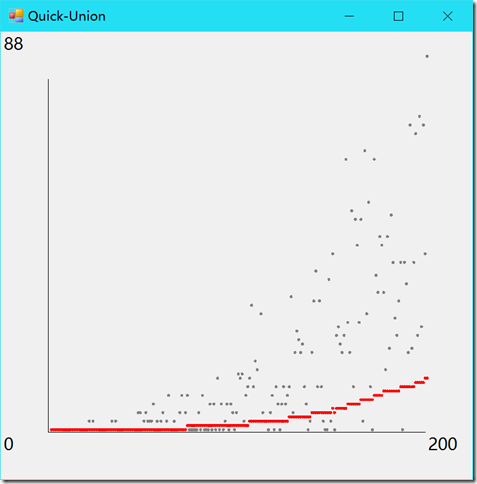
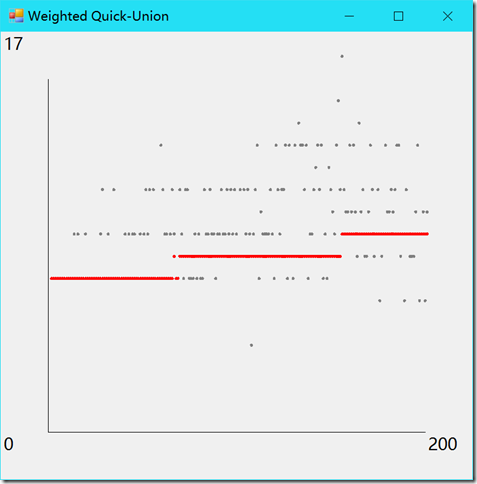
using System; using System.Linq; using System.Windows.Forms; using System.Drawing; using UnionFind; namespace _1._5._26 { /* * 1.5.26 * * Erd?s-Renyi 模型的均摊成本图像。 * 开发一个用例, * 从命令行接受一个 int 值 N,在 0 到 N-1 之间产生随机整数对, * 调用 connected() 判断它们是否相连, * 如果不是则用 union() 方法(和我们的开发用例一样)。 * 不断循环直到所有触点互通。 * 按照正文的样式将所有操作的均摊成本绘制成图像。 * */ static class Program { /// <summary> /// 应用程序的主入口点。 /// </summary> [STAThread] static void Main() { Application.EnableVisualStyles(); Application.SetCompatibleTextRenderingDefault(false); Compute(); Application.Run(new Form1()); } static void Compute() { int size = 200; QuickFindUF quickFind = new QuickFindUF(size); QuickUnionUF quickUnion = new QuickUnionUF(size); WeightedQuickUnionUF weightedQuickUnion = new WeightedQuickUnionUF(size); Connection[] connections = ErdosRenyi.Generate(size); int[] quickFindResult = new int[size]; int[] quickUnionResult = new int[size]; int[] weightedQuickUnionResult = new int[size]; int p, q; for (int i = 0; i < size; ++i) { p = connections[i].P; q = connections[i].Q; quickFind.Union(p, q); quickUnion.Union(p, q); weightedQuickUnion.Union(p, q); quickFindResult[i] = quickFind.ArrayVisitCount; quickUnionResult[i] = quickUnion.ArrayVisitCount; weightedQuickUnionResult[i] = weightedQuickUnion.ArrayParentVisitCount + weightedQuickUnion.ArraySizeVisitCount; quickFind.ResetArrayCount(); quickUnion.ResetArrayCount(); weightedQuickUnion.ResetArrayCount(); } Draw(quickFindResult, "Quick-Find"); Draw(quickUnionResult, "Quick-Union"); Draw(weightedQuickUnionResult, "Weighted Quick-Union"); } static void Draw(int[] cost, string title) { // 构建 total 数组。 int[] total = new int[cost.Length]; total[0] = cost[0]; for (int i = 1; i < cost.Length; ++i) { total[i] = total[i - 1] + cost[i]; } // 获得最大值。 int costMax = cost.Max(); // 新建绘图窗口。 Form2 plot = new Form2(); plot.Text = title; plot.Show(); Graphics graphics = plot.CreateGraphics(); // 获得绘图区矩形。 RectangleF rect = plot.ClientRectangle; float unitX = rect.Width / 10; float unitY = rect.Width / 10; // 添加 10% 边距作为文字区域。 RectangleF center = new RectangleF (rect.X + unitX, rect.Y + unitY, rect.Width - 2 * unitX, rect.Height - 2 * unitY); // 绘制坐标系。 graphics.DrawLine(Pens.Black, center.Left, center.Top, center.Left, center.Bottom); graphics.DrawLine(Pens.Black, center.Left, center.Bottom, center.Right, center.Bottom); graphics.DrawString(costMax.ToString(), plot.Font, Brushes.Black, rect.Location); graphics.DrawString(cost.Length.ToString(), plot.Font, Brushes.Black, center.Right, center.Bottom); graphics.DrawString("0", plot.Font, Brushes.Black, rect.Left, center.Bottom); // 初始化点。 PointF[] grayPoints = new PointF[cost.Length]; PointF[] redPoints = new PointF[cost.Length]; unitX = center.Width / cost.Length; unitY = center.Width / costMax; for (int i = 0; i < cost.Length; ++i) { grayPoints[i] = new PointF(center.Left + unitX * (i + 1), center.Bottom - (cost[i] * unitY)); redPoints[i] = new PointF(center.Left + unitX * (i + 1), center.Bottom - ((total[i] / (i + 1)) * unitY)); } // 绘制点。 for (int i = 0; i < cost.Length; ++i) { graphics.FillEllipse(Brushes.Gray, new RectangleF(grayPoints[i], new SizeF(5, 5))); graphics.FillEllipse(Brushes.Red, new RectangleF(redPoints[i], new SizeF(5, 5))); } graphics.Dispose(); } } }